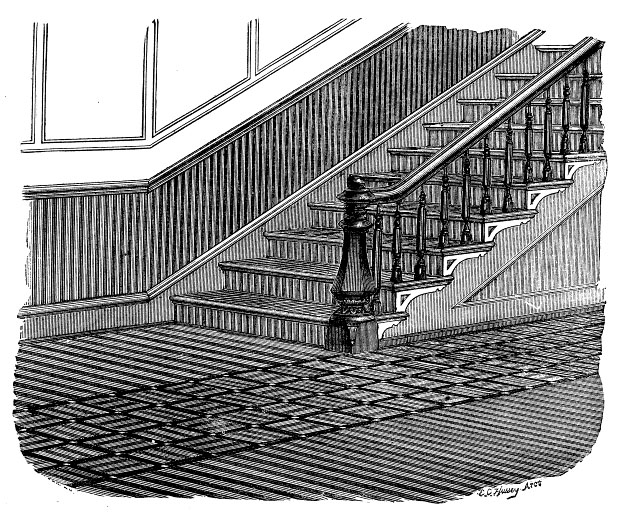IT is always a peculiarity of all valuable inventions that no sooner are they once explained than every body wonders why nobody ever thought of a thing so very simple before; and to this law very few exceptions are ever presented in its application to the common matters of every-day life. An invention has been recently brought before the public, which illustrates this principle, in the portable wainscoting and wood floor covering, specimens of which have lately been put on exhibition, manufactured after Furscheim?s idea. The invention consists in laying strips of any convenient width and length ? width and length to be uniform for the given purpose?upon a length of ordinary cotton flannel, to which they are secured by gluing. The ordinary thickness for manufacture is about one eighth of an inch, except for floors or stairs, when it may be made of double strength; while from two thirds to three fourths of an inch affords the most usual width. The joining of the strips to the fabric so that the whole may be rolled, unrolled, put up, or taken down and kept on sale like carpets, forms the main point of the invention. The strips being cut very narrow, a prettier combination of hard woods may be obtained than with tongued and grooved material. It always requires a baseboard, which materially contributes to neatness of finish; two or more kinds or styles of wood being used?and more if it should suit the person giving the order?not only in the fabric itself, but in the corresponding baseboard. If desired, a greater variety of pattern can be secured, with greater complication of design, and especially greater novelty and beauty of effect in color. As a floor covering, it may be laid in blocks, mosaic, diagonally, or in other patterns, or it may be manufactured in accordance with special designs. Hard woods only are used; and all material is first kiln-dried. Planing, cutting, splitting, sawing, and the like having preceded, the strips are firmly glued to twilled canton flannel. The fabric is easily put up, being fastened to the wall from the top with a rabbeted moulding or a fixture underneath, and firmly secured by screws or nails through the moulding or nosing to the studding. A rabbeted base secures the wainscoting at the bottom. The cost is about one half that of walnut or other hard wood, tongued and grooved; and, being portable, it may be put up in a rented house upon moving in, and taken down upon moving out, with as little trouble as any other appurtenance of upholstery, scarcely defacing the walls except to the extent of a few small screw-holes. The first cost of it for floor covering is a little more than that of ordinary oil-cloth; while, for beauty, it can hardly be exceeded.
When used for this purpose, it is nailed down with small wire nails, and a quarter-round moulding covers the joints between the tread and the riser, the top of which is secured by a fixture underneath the nosing. It might also be made the covering for ordinary hemlock counters, with the advantage of a very handsome finish.
One great advantage of the new wainscoting is that it is not materially affected by atmospheric action? that is, it is not liable to bow, draw out, shrink, or warp. These inclinations of the wooden fabric are obviated by the presence of the cloth, the tendency of which is to be held inward against the wall by atmospheric pres- sure. The strips being small, their shrinkage would be hardly perceptible were they green or unseasoned; but being thoroughly dried, the flexibility or elasticity of the cloth is sufficient to obviate even this difficulty; and, as the cloth used is cotton, it is not liable to become moth-eaten.
For cleansing purposes, a damp cloth only is used once or twice a week? though why the strips should not be joined to the flannel with insoluble glue it would be difficult to say. Albeit, when used for flooring, every separate strip is nailed to the floor and could not be removed, were the glue even decomposed.
These paragraphs afford a general description of the wainscoting, the manufacture of which has been begun by Messrs. Fairchild, Cornell & Co., with show-rooms at No. 2Th Broadway, who propose to fill orders at a given schedule of prices. The invention is well worth examining, having already received the indorsements of leading builders and architects. Among the latter may be mentioned GRIFFITH THOMAS, whose recent design, the Park Bank building, has been described.

